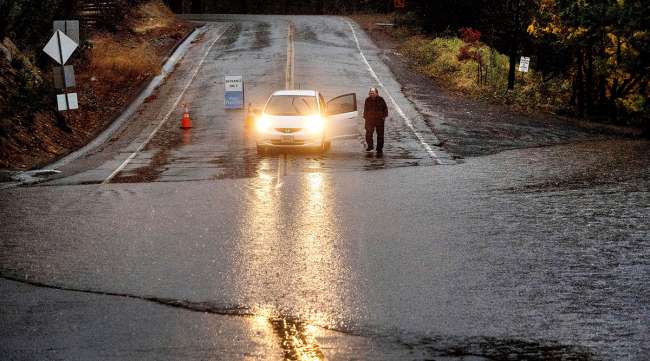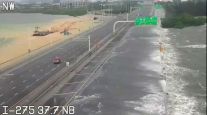Mudslides Close California Highways After Record Rain

[Stay on top of transportation news: Get TTNews in your inbox.]
Sacramento, Calif., had its rainiest day in history and downpours made the record books in San Francisco as a powerful Pacific storm ripped across the West, spilling rocks onto highways, toppling trees and leaving thousands without power.
In downtown Sacramento, 5.44 inches of rain fell Oct. 24, surpassing a high mark set in 1880. Blue Canyon to the east was inundated with almost twice that amount. Just over 4 inches dropped in San Francisco, making it the city’s fourth-rainiest day in records going back to the 1849 gold rush.
“We had been messaging that this would be a historic storm and it looks like it ended up materializing in that aspect, at least with the rain totals,” said Cory Mueller, a National Weather Service meteorologist in Sacramento.
The powerful storm slammed onshore with near hurricane-force winds, creating waves as high as 30 feet and bringing a plume of moisture that soaked Northern California, triggering mudslides and rock slides that closed highways 50 and 70. Almost 115,000 people across California and more than 60,000 in Washington state are without power, according to PowerOutage.us.
We captured add'l views of the Hwy 70 slide in Butte County about 8 mi N of Pulga from earlier today.
Storms are expected to continue overnight. Stay home, stay safe!
Before your Monday morning commute, get updates on road closures at https://t.co/WvicXhSbxn #KnowBeforeYouGo pic.twitter.com/lvTIGA4ro8 — Caltrans HQ (@CaltransHQ) October 25, 2021
Highway 50 is closed to eastbound traffic in El Dorado County and highway 70 is closed in parts of Butte and Plumas counties due to a mudslide, the California Department of Transportation said on its website. Some larger trucks have been banned from 70 and motorists are required to have chains on their tires.
While the initial blast was warm, bringing heavy rain even to some high elevations in the Sierra Nevada, cooler temperatures have arrived at the mountaintops, ensuring snow will fall by the foot Oct. 25, Mueller said.
The deluge set records but probably won’t end California’s drought, which had covered the state’s entire landscape through last week, Mueller said. It will likely put an end to some of the wildfires plaguing the northern half of the most populous U.S. state, however.
“This will end it for a while, but we will continue to now see debris flows as a possibility,” Mueller said.
California’s woes came from a system called an atmospheric river, a Pacific storm that can unleash about the same amount of water that flows out of the mouth of the Mississippi River. A U.S. Army Corps of Engineers study found such events caused 84% of flood damage across 11 western states over a 40-year period. On average, they cause about $1.1 billion in damage annually. The most potent deluges don’t usually come for California until December and January, said David Roth, a senior branch forecaster at the U.S. Weather Prediction Center.
Well, looks like it's official: Sacramento experienced its *wettest day on record* yesterday, shortly after experiencing its longest consecutive dry spell on record...all in the midst of an extreme to record-breaking drought. Wow. #CAwx #CAwater https://t.co/Iv2uCi1b7k — Daniel Swain (@Weather_West) October 25, 2021
California is set to dry out in coming days, Mueller said.
Want more news? Listen to today's daily briefing below or go here for more info:




